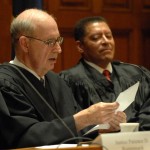2010 Jenkins Competition Finals April 6
 This is a week of great competition: the NCAA finals, the Brewers home opener, and the final round of the 2010 Jenkins Honors Moot Court Competition. Please congratulate the following teams who have advanced to the final round:
This is a week of great competition: the NCAA finals, the Brewers home opener, and the final round of the 2010 Jenkins Honors Moot Court Competition. Please congratulate the following teams who have advanced to the final round:
Gabe Johnson-Karp and Alexandra Grimley
Ashley Roth and Emily Lonergan
These two teams are going for a rematch in the final round.
All members of the Law School community are invited to attend the final round, which will take place on Tuesday, April 6 at 6:00 p.m. at the Federal Courthouse, with a reception immediately following at the Milwaukee Club.
To attend the final round, please email Carol Dufek at carol.dufek@marquette.edu.


